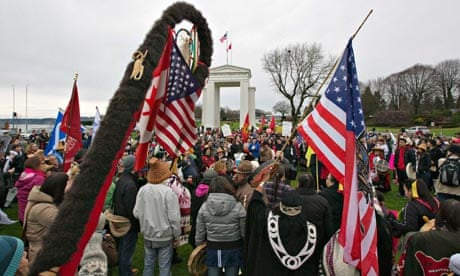The Canadian prime minister, Stephen Harper, has agreed to a meeting with First Nations leaders following indigenous protests sparked by a hunger strike.
Since 10 December there have been road and rail blockades across Canada, flash mobs and solidarity events as far away as New Zealand, in the biggest grassroots social movement in North America since Occupy.
On Algonquin island in the Ottawa river, within view of parliament, Chief Theresa Spence of Attawapiskat, a poor aboriginal community, has been living in a teepee in sub-zero temperatures subsisting on liquids for 27 days. Two other Aboriginal elders were in week four of their fasts when Harper agreed to meet to discuss aboriginal rights and economic development.
Spence said she would continue her fast until the meeting had produced concrete action and a promise of consultations. "I'll still be here on my hunger strike until that meeting takes place," she said. "We'll see what the results are … because there are a lot of issues that we need to discuss."
Harper recently forced through parliament two budget bills, each more than 400 pages long. MPs had limited time to study the hundreds of legislative changes, let alone debate and amend them. The protest movement, under the slogan Idle No More, started as a campaign by four women who feared that the bill's changes to the Indian Act and environmental deregulation would disproportionately affect First Nations peoples, many of whom live like second-class citizens.
News of the meeting, scheduled for 11 January, has done little to slow the momentum of the movement, a self-professed leaderless and bottom-up mobilisation driven by Aboriginal women and media-savvy youth that has gained increasing sympathy from the broader public.
Further disruption of road and rail routes was planned this weekend. On Wednesday a court ordered an end to a nearly two-week blockade of CN Rail in Sarnia, Ontario, the city with the worst industrial pollution in Canada.
First Nations constitutionally protected land rights are often seen as red tape in the way of the government's economic plans. Clayton Thomas-Muller, a Manitoba Cree running the Indigenous Environmental Network's tar sands campaign, called for a "separation of oil and state".
"400 years ago we had Jesuit priests come into our First Nations in black robes promising a better way of life by changing the way we communicated with our creator," he said. "Today, CEOs come into our communities in black suits promising a better way of life if we change the way we relate to the sacredness of mother earth."
Nina Segalowitz, an Inuit throat singer attending a flash mob in a Montreal mall, said: "Hopefully people will understand it's not just an Aboriginal issue. Everyone needs to protect the legacy of the earth that we're going to leave for generations to come."

Comments (…)
Sign in or create your Guardian account to join the discussion